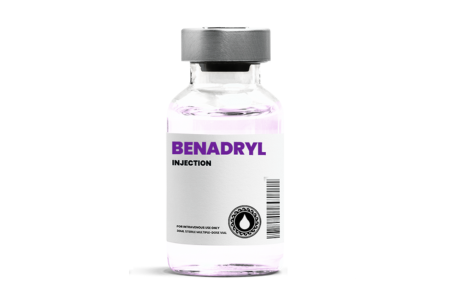Benadryl, or diphenhydramine, typically stays in your system for 4 to 6 days. Detection times may vary based on individual factors.
Benadryl is a commonly used antihistamine for relieving symptoms of allergies, colds, and insomnia. Upon ingestion, its effects usually become noticeable within 30 minutes to an hour. While the active effects of Benadryl last for 4 to 6 hours, its half-life—the time it takes for half of the drug to be eliminated from the body—is around 4.
3 hours in healthy adults. This means that it takes approximately 4. 3 hours for the amount of Benadryl in the bloodstream to reduce by half. However, it can take several half-lives for the drug to be entirely cleared from your system. Factors such as age, metabolic rate, organ function, dosage, and frequency of use can influence the exact duration Benadryl remains detectable in the body.
Absorption And Half-life
Ever wonder how long Benadryl, the go-to antihistamine for allergies, stays active in your system? Understanding the absorption and half-life of Benadryl is key. These factors determine the duration of its effects and how often you can safely take it. Let’s dive into the science of how Benadryl works in the body and how long it lingers.
Absorption In The Body
When you take Benadryl, your body starts to absorb it quickly. It’s designed to relieve allergies fast. Here’s a breakdown of what happens:
- Oral ingestion: If you take a pill, it dissolves in your stomach. Your small intestine then absorbs it.
- Fast action: It typically takes about 20 to 30 minutes to work. You might start to feel relief quickly.
- Peak levels: Blood levels peak in about 2 to 4 hours. This is when Benadryl is most effective.
Individual factors can affect absorption:
- Your metabolism: Everyone is different. How fast your body processes substances can vary.
- Food intake: Eating before taking Benadryl may slow down absorption. It doesn’t stop it, just takes a bit longer.
- Form: Liquid forms may absorb faster than pills. Choose the best option for your needs.
Let’s put this into perspective with a table:
| Form | Absorption Time | Peak Level |
|---|---|---|
| Pill | 20-30 minutes | 2-4 hours |
| Liquid | 10-20 minutes | 1-2 hours |
Half-life Of Benadryl
The half-life of a drug is the time it takes for its active substance to reduce by half in the body. For Benadryl, this is crucial:
- Typical half-life: It ranges between 4 to 8 hours. This varies from person to person.
- Full clearance: Most of Benadryl leaves your system in about 24 hours. But it can take longer for some.
- Age matters: Older adults may have a longer half-life for Benadryl. Their bodies process drugs more slowly.
Consider these points:
- Health conditions: If you have liver or kidney issues, Benadryl may stay in your system longer.
- Multiple doses: Taking Benadryl over several days can extend the half-life. Be mindful of your dosage.
- Drug interactions: Other medications might affect how long Benadryl stays in your system.
Here’s a simple table to illustrate the half-life:
| Age Group | Typical Half-Life | Time to Clear |
|---|---|---|
| Adults | 4-8 hours | 24 hours |
| Older Adults | 7-12 hours | 24-48 hours |
Remember, these are averages. Your experience may vary. Always follow the guidance of a healthcare professional.

Benadryl IV
Benadryl, known generically as diphenhydramine, is a widely used antihistamine that offers quick relief from various allergic symptoms, such as itching, hives, and swelling.
Factors Affecting Duration
Understanding how long Benadryl stays in your system is crucial for safe use. Several factors play a role in this duration. These include your metabolism, liver function, and how often you take the medicine. Let’s delve into the specifics of each factor.
Metabolism And Liver Function
Your body’s metabolism and liver function are key in processing Benadryl. Simply put, your metabolism speed can make the drug leave faster or linger longer. Here’s what influences how your body handles Benadryl:
- Age: Younger people often process drugs quicker than older adults.
- Overall health: A strong, healthy liver breaks down Benadryl efficiently.
- Genetics: Some genes make for speedy or slow metabolizers.
A table to illustrate how liver function can affect Benadryl’s duration in the body:
| Liver Function | Effect on Benadryl Duration |
|---|---|
| Healthy | Shorter duration in system |
| Compromised | Longer duration in system |
Dosage And Frequency Of Use
The amount of Benadryl you take and how often you take it also affect how long it stays in your system. Here are some points to consider:
- Higher doses may take longer for your body to fully clear.
- Regular use can lead to the drug building up in your system.
- Single doses are typically processed quicker than multiple doses.
Here’s a simple breakdown:
| Dosage | Frequency of Use | Duration in System |
|---|---|---|
| Low | Single | Shorter |
| High | Multiple | Longer |
Remember, it’s important to follow the recommended dosage and consult a doctor for advice on frequency of use. This ensures the medicine helps you without staying too long in your system.

Detection In Different Tests
Have you ever wondered how long Benadryl stays in your system? Different tests can detect it for various times. Let’s dive into how urine and blood tests find Benadryl.
Urine Tests
Urine tests are common for checking drugs in your system. They are easy and quick. For Benadryl, here’s what you need to know:
- Benadryl can show up in urine tests for up to 2-4 days after you last take it.
- The detection time can vary based on how much you took and your body’s metabolism.
Doctors use these tests to see if you’ve taken Benadryl recently. It’s important for treatment or medical advice. Here is a simple table showing the detection time:
| Amount Taken | Detection Time in Urine |
|---|---|
| Small Dose | Up to 2 Days |
| Large Dose | Up to 4 Days |
This table helps us understand the impact of dose on detection time.
Blood Tests
Blood tests are more detailed but less common for Benadryl. They show:
- Benadryl can be found in blood tests for about 24 hours after taking it.
- This time can change based on your health and how much you took.
Blood tests give a clear picture of recent use. They are used in serious cases or when precise information is needed. Here are some points to remember:
- They are more invasive than urine tests.
- They provide a shorter detection window but are very accurate.
Understanding these tests helps doctors give the best advice or treatment. It also helps you know what to expect if you’ve taken Benadryl.
Effects Of Prolonged Use
Benadryl, a popular antihistamine, helps many people with allergies. But what happens when you use it a lot? It’s important to know how long Benadryl stays in your system and the effects of using it for a long time. Let’s dive into what happens to your body with regular use.
Tolerance And Dependence
Using Benadryl often can lead to your body getting used to it. This means you might need more to feel the same effects. Here’s what you should know:
- Tolerance: Over time, your body may not respond to the usual dose.
- Dependence: You might feel like you need Benadryl to sleep or manage allergies.
When you use Benadryl a lot, your body’s reaction to the drug changes. At first, a small amount may be enough. But later, you might need more to get the same relief. This is called tolerance. Dependence is when your body starts to rely on the drug to feel normal. If you stop taking it, you might not feel right. You could have trouble sleeping or feel uneasy. It’s key to use Benadryl as directed to avoid these issues.
Impact On The Body
Long-term use of Benadryl can affect your body in several ways. Below are some changes you might notice:
| Part of the Body | Effect of Prolonged Benadryl Use |
|---|---|
| Brain | May cause memory problems or confusion, especially in older adults. |
| Heart | Can lead to an irregular heartbeat or other heart-related issues. |
| Digestive System | Could slow down digestion, leading to constipation or upset stomach. |
It’s not just about feeling sleepy. Benadryl can make it hard to focus and remember things. In older folks, it can even lead to serious confusion. Your heart might not beat right, and your stomach could get upset. Always talk to a doctor before using Benadryl for a long time. They can help you understand the risks and keep your body safe.
Clearance From The System
Wondering how long Benadryl, also known as diphenhydramine, lingers in your system? The answer lies in understanding how your body processes this medication. Clearance from the system refers to how the body breaks down and gets rid of Benadryl. It’s a journey from ingestion to complete elimination. This trip depends on several factors, including your metabolism and the medicine’s half-life. Let’s dive into the details of how Benadryl leaves your body.
Metabolism And Excretion
After you take Benadryl, your body gets to work. Metabolism starts in the liver, where enzymes break down the drug. This process turns it into substances that are easier to remove. The main route of excretion is through your urine. Here’s what happens in the body:
- The liver metabolizes Benadryl into by-products.
- The kidneys filter these by-products out of the blood.
- Finally, you excrete these by-products when you urinate.
Safety And Precautions
Knowing how long Benadryl stays in your system is vital for safety. This common antihistamine can cause side effects and interact with other drugs. So, it’s important to take it with care. Here, we will explore key safety measures. We will look at how Benadryl interacts with other medications. Also, we’ll discuss its effects on special populations like children, pregnant women, and the elderly.
Interactions With Other Medications
When Benadryl, also known as diphenhydramine, enters your system, it can affect how other medicines work. Here’s what you need to know:
- Other CNS Depressants: Benadryl can increase sedation when taken with other central nervous system depressants. These include sleeping pills, sedatives, muscle relaxants, or medicines for anxiety.
- Alcohol: Combining Benadryl with alcohol can enhance drowsiness and dizziness, making activities like driving very risky.
- MAO Inhibitors: Taking Benadryl with MAO inhibitors can lead to a dangerous spike in blood pressure.
Check out this table for a quick guide on drug interactions:
| Medication Type | Interaction with Benadryl | Action to Take |
|---|---|---|
| Opioids | Increases risk of sedation and respiratory depression. | Consult your doctor before combining. |
| Antidepressants | May increase side effects like dry mouth and constipation. | Talk to your healthcare provider for alternatives. |
| Antihypertensives | Can reduce the effectiveness of these blood pressure drugs. | Monitor your blood pressure closely. |
Special Populations
Benadryl can affect different people in different ways. Here’s what special groups should consider:
- Children: They are more sensitive to the effects of Benadryl. It can cause excitability rather than drowsiness.
- Elderly: Older adults may experience stronger side effects, such as confusion or difficulty urinating.
- Pregnant Women: Benadryl should only be used if clearly needed. It’s a category B drug, which means there are no proven risks in humans.
For these populations, follow these tips:
- Always start with the lowest effective dose.
- Monitor for any unusual side effects.
- Consult a healthcare provider before starting or stopping Benadryl.
Remember, this table shows the general guidelines, but your doctor knows best:
| Population | Precaution | Recommended Action |
|---|---|---|
| Children under 6 | Not recommended without doctor’s advice. | Seek pediatrician’s guidance. |
| Pregnant Women | Use only if necessary. | Consult with an OB-GYN. |
| Elderly | Prone to stronger side effects. | Start with lower doses; monitor closely. |
Conclusion
Understanding how long Benadryl remains in your system is crucial for safe use. It generally clears within 72 hours, but factors like metabolism and dosage play roles. Always consult healthcare professionals before starting or stopping medication. Remember, responsible use ensures safety and effectiveness in managing allergies or sleep issues.






